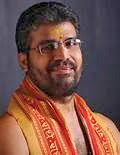The Process of Yoga : 2.5 - Swami Krishnananda.
================================================================
================================================================
Tuesday, May 17, 2022. 06:00.
Chapter 2: The Structure of the Universe-5.
===============================================================
The Samkhya doctrine gives us a clue to this relation between the two terms of relation, consciousness and matter. The evolutionary scheme of the Samkhya is very helpful to us in understanding this mystery. On one side there is a world, and on the other side there is the perceiver of the world. Both these seem to be running parallelly along two altogether different lines of approach; but these parallel lines seem to meet at a point. How can parallel lines meet? Geometry tells us that parallels never meet, but today science tells us that parallels can meet in infinity. This is something super-geometrical. Infinity is the meeting point of parallel lines. Purusha and prakriti meet at one point, which is the point of infinity. We have been told that light travels in straight lines, that it never bends; but today scientists tell us that light can bend under certain given conditions, and it does not always travel in straight lines. Therefore, parallel lines do meet, though at a point of infinity.
Now, infinity is a term that we give to incomprehensible positions of things beyond the spatial and temporal limitations of objects. Such a point of infinity is posited by the Sankhya. Prakriti and purusha meet at a point which is called the bindu in tantric terminology. The bindu, or the universal point, is a centre wherein the element of consciousness and the element of objects converge into a single subjectivity which is neither material nor conscious in the ordinary sense of the term. The Samkhya tells us this is the principle of mahat-tattva commingled with pure Self-consciousness called the supreme ahamkara. The ahamkara tattva mentioned here by the Samkhya as inseparable from the mahat is not the egoism that we are familiar with, but pure indeterminate Self-consciousness.
This is the beginning of creation. This is the bindu, this is the nada, and this is the kala from where the universal reverberation of omkara commences. There we have neither prakriti nor purusha, neither the object nor the subject, neither matter nor consciousness. What is there, no one knows. That indeterminate something is nasadasi'nnosadasit, says the Rig Veda. We do not know whether existence was or non-existence was, whether we were or something was, whether matter was or consciousness was. “Something existed,” says the Samkhya, says the Rig Veda, say the scriptures, and this is what has been proclaimed by the masters in Yoga. This is the supreme silence of Truth or Reality.
Here we shut our mouths forever. We speak not, because there is no object to be spoken about and there is no speaker thereof. This silence is the real mauna of creation. In the very beginning of the great Smriti of Manu we are told, “Asid asitidam tamobhutam aprajnatam alakshanam, apratargyam avijneyam prasuptamiva sarvatah.” Manu commences his Smriti in this manner. Asid asitidam tamobhutam aprajnatam alakshanam: unknown and indefinable darkness prevailed, as it were, in the beginning of things – darkness due to the excess of light. It was not the absence of light that was the cause of darkness; the darkness was due to the excess of light. When light is too much, it looks like darkness. Suppose ten million Suns descend into this hall; it would be like darkness for us. We would simply close our eyes and be dazzled to such an extent that we would see pitch darkness. It is said that when Bhagavan Sri Krishna showed his Visvarupa in the court of the Kauravas, all people closed their eyes and saw nothing, as if it was midnight, but it was the blazing light of tens of millions of Suns which looked like darkness to the eyes of the mortals. So, the tamas which Manu describes, and the non-existence which the Rig Veda speaks of in its Nasadiya Sukta, is not the non-existence of things and not the darkness of the absence of light, but the darkness which is the effect of a transcendent luminosity beyond the capacity of sensory perception, and a non-existence of everything sensorily observed. It is non-existence, yes. But it is non-existence of everything that is objective, external, temporal, spatial, and even what can be called subjective.
Such a mighty mystery is regarded as the beginning of creation. And from that bindu, nada, kala, from that supreme non-existence of all temporal existence, from that supreme light which is the darkness of mortal perception, two lines of evolution began to emanate – on one side the line of objects, and on the other side the line of subjects. The scheme of creation as the object world is known as the five elements of perception; and the scheme of evolution on the other side – as the line of observation or perceptibility, consciousness – is known as the jiva. So we have the jiva-srishti on one side, and the jagat-srishti on the other side. Samsara is nothing but the belief in the separability of the object from the subject of perception, and moksha or liberation is nothing but rising to the point of that unity of prakriti and purusha where one does not see, and there is nothing to be seen.
To be continued ....
================================================================






Comments